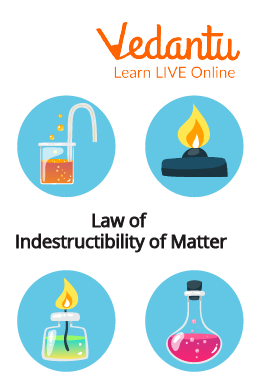




Why the Law of Indestructibility of Matter Matters in Chemistry
Scientists started looking at how and why chemicals react as they developed more exact theories about elements, compounds, and mixtures.

Law of Indestructibility of Matter
A. Lavoisier, a French chemist, provided the groundwork for the scientific study of matter when he stated that substances respond according to specific rules. The laws of chemical combination are what are known as these laws. Later, Dalton's Atomic Theory of Matter was built around these principles.
History of The Scientist


Name: Antoine-Laurent de Lavoisier
Born: 26 August 1743
Died: 8 May 1794
Field: Biologist, Chemist
Nationality: French
What is the Law of Conservation of Mass?
According to the rule of conservation of mass, no new mass will be formed during a chemical reaction in an entirely closed system. Furthermore, regardless of the kind of chemical reaction that takes place, the law of conservation of mass dictates that mass is preserved from reactants to products. The law of conservation of mass is simply defined as what goes in should come out.
Law of Conservation of Mass Examples

Chemical Reaction Taking Place
Following are some examples of conservation in a straightforward combination reaction involving the chemical combination of two substances: 200g A plus 100g B. The mass on the left side of the arrow will always equal the mass on the right side of the arrow in a closed system where none of the reactants is lost during the reaction.
In a double-replacement reaction, for instance, the components of the reactants have changed positions and are now AB + CD → AC + BD. In a wholly enclosed system, if 150g AB and 250g CD are chemically reacted, the combined masses of the products AC and BD will be 400g.
Limitations of Law of Indestructibility of Matter
According to the definition of the rule of conservation of mass, any physical or chemical change must result in an equal balance of reactant and product masses. However, some of the mass in a nuclear reaction is transformed into energy, leading to an imbalance in the mass of the reactants and products. The overall mass is not conserved as a result. This is the mass conservation principle's constraint.
According to Einstein's theory, the other restriction on mass conservation is that energy and mass can be converted into one another. As a result, both the system's mass and energy must be conserved for the law of conservation of mass to be true.
Applications of Law of Indestructibility of Matter
The ability to forecast a system's macroscopic behaviour without having to think about the microscopic specifics of how a physical process or chemical reaction would unfold is a key function of conservation laws.
Solved Examples
1. Why is the conservation of mass believed to be a part of the conservation of energy?
Ans: It has been found that in nuclear reactions, the mass of the reactants is greater than the mass of the products. The mass defect, also known as the difference in mass, is said to be transformed into energy via Einstein's equation. We should call it the law of conservation of mass and energy as a result.
2. Carbon dioxide and calcium oxide are both produced in equal amounts by 10 g of calcium carbonate. Explain this reaction using the mass conservation law.
Ans: Following the law of conservation of mass:
Reactant mass = Product mass.
10 g of Calcium carbonate = 6.2 g of Calcium oxide + 3.8 g of Carbon-dioxide.
10 g of reactant = 10 g of products
Thus, it is demonstrated that the above reaction adheres to the law of conservation of mass.
3. 36 grams of water are created when 4 grams of hydrogen and some oxygen combine. Determine the amount of oxygen that must have been consumed using the law of conservation of mass.
Ans: Mass given for each compound is as follows:
Hydrogen = 4g
Oxygen = x g
Water = 36 g
Following the Law of conservation of Mass:
Mass of reactants = Mass of products
4 g + x g = 36 g
x g = 36 g – 4 g
x = 32 g
Therefore, 32 g of oxygen was used.
Important Points to Remember
As long as there is no energy loss during a chemical reaction, the law of conservation of mass applies. As long as the frame of reference is inertial, the law of conservation of mass applies in terms of physics. This is because we are unable to characterize all energies in a non-inertial frame.
Conclusion
According to the rule of conservation, the mass of the products is dependent on the mass of the reactants. Based on the mass of the reactants utilized in the reaction, the law of conservation of mass is used to forecast the mass of the products that will be produced.
FAQs on Law of Indestructibility of Matter Explained
1. What is the law of indestructibility of matter in simple terms?
The law of indestructibility of matter, also known as the law of conservation of mass, states that matter cannot be created or destroyed in an isolated system during any chemical reaction. This means the total mass of the substances you start with (reactants) will always be equal to the total mass of the substances you end up with (products).
2. Can you give a real-world example of this law?
Certainly. Imagine burning a log in a perfectly sealed, fireproof container. Before burning, you weigh the log and the oxygen inside the container. After the log has turned to ash, if you weigh the container again (including the ash, smoke, and any gases produced), the total mass will be exactly the same as what you started with. The atoms simply rearranged themselves from wood and oxygen into ash, carbon dioxide, and water vapour.
3. Who discovered the law of conservation of mass?
The law of conservation of mass was established by the French chemist Antoine Lavoisier in the late 18th century. Through his meticulous experiments, he was the first to demonstrate that the total mass remains constant during a chemical change, which became a cornerstone of modern chemistry.
4. Why is this law so important in chemistry?
This law is fundamental for several reasons:
- It is the basis for balancing chemical equations. We balance equations to ensure the number of atoms of each element is the same on both sides.
- It allows chemists to perform quantitative calculations, a practice known as stoichiometry, to predict the amount of reactants needed or products formed in a reaction.
- It reinforces the idea that chemical reactions are just rearrangements of atoms, not the creation or destruction of them.
5. Does the law of indestructibility of matter apply to nuclear reactions?
No, not strictly. In nuclear reactions, like those happening in the sun or in a nuclear reactor, the law is modified. A very small amount of mass is converted into a massive amount of energy, as explained by Albert Einstein's famous equation, E=mc². In these cases, it is the total mass and energy combined that are conserved.
6. When a candle burns, it disappears. How does this follow the law of conservation of mass?
This is a common point of confusion because it happens in an open system. The candle wax doesn't just vanish; it reacts with oxygen from the air. The mass of the wax is converted into invisible gases (like carbon dioxide and water vapour) and some soot, which all escape into the room. If you could capture and weigh all these products, their total mass would equal the mass of the wax that burned plus the mass of the oxygen that was used.
7. What is the difference between the law of conservation of mass and the law of constant proportions?
They are both fundamental laws but describe different things:
- The Law of Conservation of Mass applies to an entire chemical reaction, stating that the total mass of reactants equals the total mass of products.
- The Law of Constant Proportions applies to the composition of a specific chemical compound, stating that a compound like water (H₂O) will always contain hydrogen and oxygen in the same fixed ratio by mass, no matter how it is made or where it is found.





































